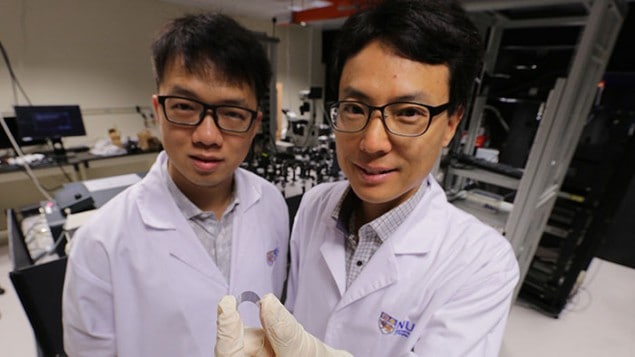Flash Physics is our daily pick of the latest need-to-know developments from the global physics community selected by Physics World‘s team of editors and reporters

Terahertz waves from a flexible source
A new low-cost terahertz wave source could lead to the development of portable, non-invasive screening devices. A team of engineers led by Yang Hyunsoo of the National University of Singapore (NUS) has developed a new flexible device that emits terahertz (THz) electromagnetic radiation. THz waves lie in between infrared and microwaves on the electromagnetic spectrum. As non-ionizing and non-destructive radiation, the waves can travel through materials including semiconductor wafers, woods and clothes. This makes them ideal for screening processes such as cancer diagnosis, detecting explosives and safety surveillance. However, current devices producing THz waves are bulky, multi-component systems. In contrast, the NUS team has developed a thin, flexible source. The device is made of non-magnetic and ferromagnetic metallic films that are 12 nm in thickness. The THz emission is driven by a laser beam. The laser excites spin currents, causing the inverse spin Hall effect to generate transient charge currents. This results in THz emission. The waves can be produced by a low-power laser and the system has higher power output than standard THz devices. The group has also demonstrated a low-cost fabrication method and hopes the finding could lead to new portable and low-cost scanning devices. The work is presented in Advanced Materials.
The push and pull of galaxy voids and groups
The Milky Way is being repelled by an extragalactic region nearly devoid of galaxies. A team of scientists led by Yehuda Hoffman of the Hebrew University of Jerusalem in Israel has confirmed that the motion of the Local Group of galaxies – which includes the Milky Way – is partly determined by the concentration of galaxies in other regions. The Milky Way and neighbouring galaxies have a peculiar velocity, which is not explained by the universe’s rate of expansion. In the past it has been suggested that this velocity is due to areas of space having different densities of galaxies. A high-density region is thought to attract galaxies, while a low-density region repels. Previously, studies of the Shapley concentration – a nearby region with a high galaxy density – have confirmed an attractive force on the Local Group. However, confirming whether a galaxy deficiency is repulsive has proved challenging because such voids are dark and difficult to study. Now, Hoffman’s team has been able to create a 3D model of galaxy flow using data from various powerful telescopes, including the Hubble Space Telescope. They were specifically interested in a void on the opposite side of the Local Group to the Shapley concentration. The research confirmed that the Local Group and other neighbouring galaxy clusters are flowing away from the void. The combination of this so-called dipole repeller and the Shapley attractor explains the direction and value of the peculiar velocities exhibited by Milky Way and neighbouring galaxies. The finding is presented in Nature Astronomy.
Bevelled edges confound topological protection

The much vaunted protection from backscattering afforded by topological materials could be diminished by the real-world effects. That is the conclusion of Jianhui Wang and Yigal Meir of Ben-Gurion University and Yuval Gefen of the Weizmann Institute of Science in Israel, who have calculated how bevelled edges affect the flow of electrons in a quantum spin-Hall phase 2D topological insulator. Electrons in one spin state will only flow clockwise around the edges of such a material, while electrons in the opposite spin state will only flow anticlockwise. For an electron to backscatter from a defect in its path and flow in the opposite direction, it must flip the direction of its spin. However, spin flips are forbidden by symmetry considerations and therefore electrical currents flowing around the edge of the material are “topologically protected” from backscattering. This protection means that such materials have very high electron mobility and could be used to create high-speed electronic devices. In practice, however, 2D topological insulators have a finite thickness and this means that the edges could be bevelled rather than abrupt. Wang, Meir and Gefen looked at what happens when the electrical potential of the atomic lattice drops off at the edge of a topological insulator. When the drop-off is gradual, they found that electrons in a specific spin state can flow in both directions – which means that backscattering is possible. Writing in Physical Review Letters, the researchers say: “This calculation underpins the fragility of the topological protection in realistic systems, which is of crucial importance in proposed applications.”
Societies call on Trump to rescind visa ban
More than 150 scientific societies and institutions, including the American Physical Society and the American Institute of Physics, have published an open letter calling on US president Donald Trump to reverse his 27 January executive order on visas and immigration. Last week, Trump signed an order that suspends the US Refugee Admissions Programme by 120 days with anyone arriving in the US from seven Muslim-majority countries – Iraq, Syria, Iran, Libya, Somalia, Sudan and Yemen – facing a 90 day visa ban. Drafted by the American Association for the Advancement of Science, the letter says that the order will “have a negative impact on the ability of scientists and engineers in industry and academia to enter, leave from and return to, the United States”, adding that the move will “discourage many of the best and brightest international students, scholars, engineers and scientists from studying and working in the United States”. The societies add that they are ready to assist the administration with formulating an immigration and visa policy.
- You can find all our daily Flash Physics posts in the website’s news section, as well as on Twitter and Facebook using #FlashPhysics.



